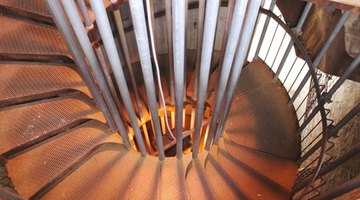How Do I Replace Carpeted Spiral Treads With Laminate Wood?
Spiral staircases offer an excellent way to create access to upper levels in rooms where space is too limited for a traditional staircase. The frames are typically welded metal with the steps, like spokes, running out from a central metal post or pipe. The treads themselves are made up of two layers, a plywood base that sits inside the tray of the rectangular stair frame and the tread that is attached to the top, which can be covered in carpet or other flooring. You will need to replace this top tread with your choice of laminate wood flooring, and trim out the edge to match.

-
Remove the screws from the stair tread frame. These are typically found on the bottom or edge of the metal tray, and will usually have Phillips heads. Use a cordless drill for quick removal. Lift the tread from the frame and flip it over to expose the plywood bottom. If there are screws, the two pieces can probably be separated; if not, you will need to cut a new base from 3/4-inch plywood.
-
Separate the tread from its base if possible. If it cannot be separated, set a piece of 3/4-inch plywood, a little larger in all directions than the tread, on top of the tread frame so that it extends past the edge of the frame in all directions. Trace the inside of the tray's top edge onto the plywood from underneath with a pencil. Cut this piece out with a jigsaw and use it as a template to make as many bases as you have steps.
-
Remove the carpet from the tread top. Remove the staples from the bottom edge with a pry bar. Loosen any glue holding the carpet with a chisel. Set this piece on a sheet of 3/8 plywood and mark its outline. Repeat for each step.
-
Lay out enough laminate flooring to cover a tread. Snap the edges together. Some will slide straight in, and others require a slight tilt. Follow the instructions with your flooring. Turn the flooring face down and place a 3/8-in. plywood tread on its back. Trace the outline onto the flooring and cut it out with a jigsaw. Repeat for each step.
-
Apply construction adhesive to the back of one set of flooring pieces and apply them to a plywood tread top. Measure the outside edges of this piece and cut the appropriate edge trim to fit. You can use a bullnose molding in a matching color, or find trim from the same maker as the flooring.
-
Check the angles of the corners with an angle finder. Place one leg of the finder on each face of the corner. The angle will be marked in the indicator. Use one-half of this angel to cut the miter for each piece. Glue the trim around the tread top, with its top edge flush with the flooring, with construction adhesive.
-
Place a tread base into a tray and drive the screws you removed into its edge or bottom, depending on the frame. Place a tread top on top of the base. Drive 1-1/4-inch fine-thread drywall screws up through its bottom to fasten the tread in place. Repeat for each step. Use six screws per step.
References
- "Laminate Flooring 1-2-3"; Benjamin W. Allen and Jeff Day; 1999
Writer Bio
Mark Morris started writing professionally in 1995. He has published a novel and stage plays with SEEDS studio. Morris specializes in many topics and has 15 years of professional carpentry experience. He is a voice, acting and film teacher. He also teaches stage craft and lectures on playwriting for Oklahoma Christian University.
Photo Credits
- spiral stair image by firstangel999 from Fotolia.com
More Articles



